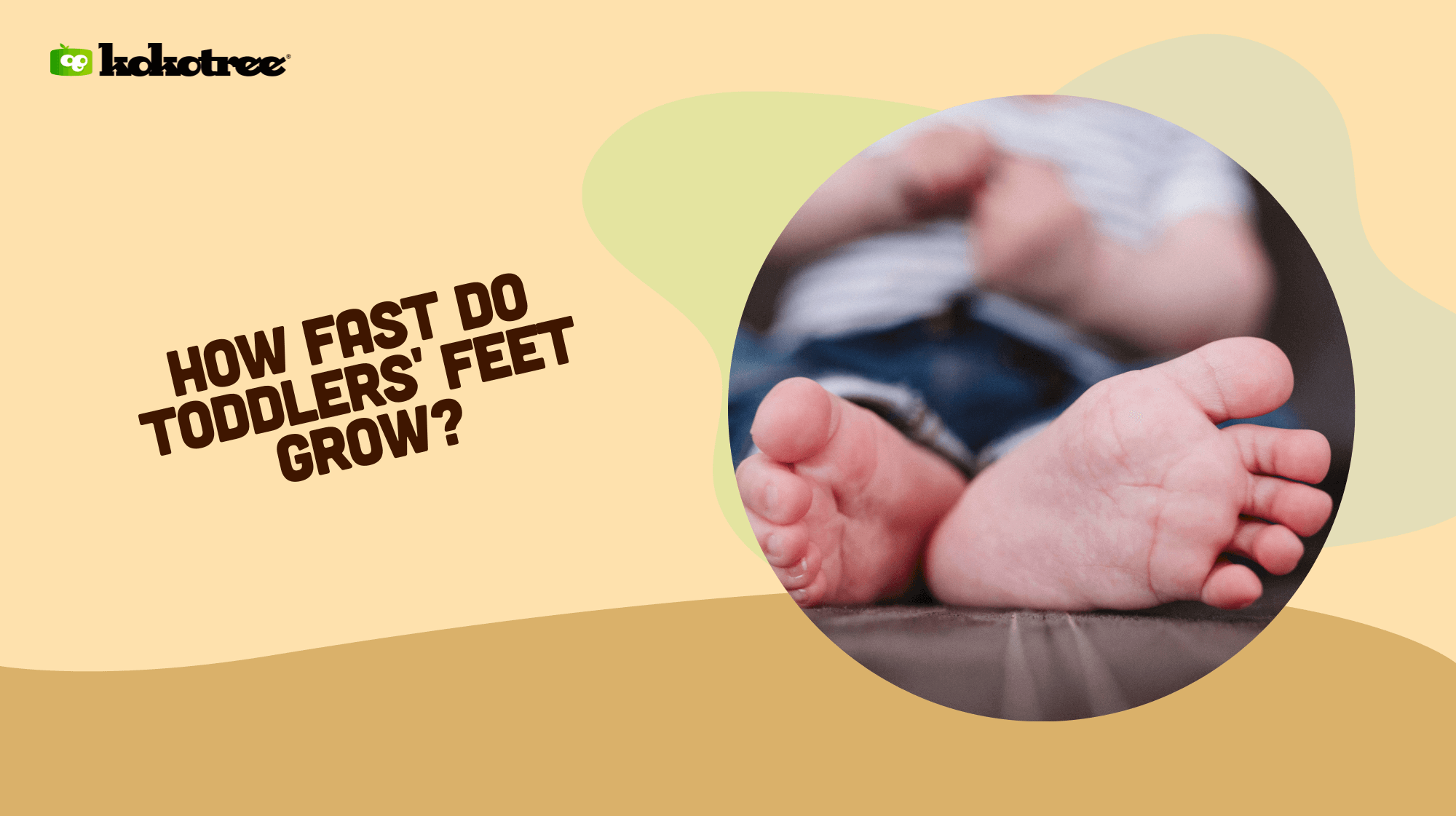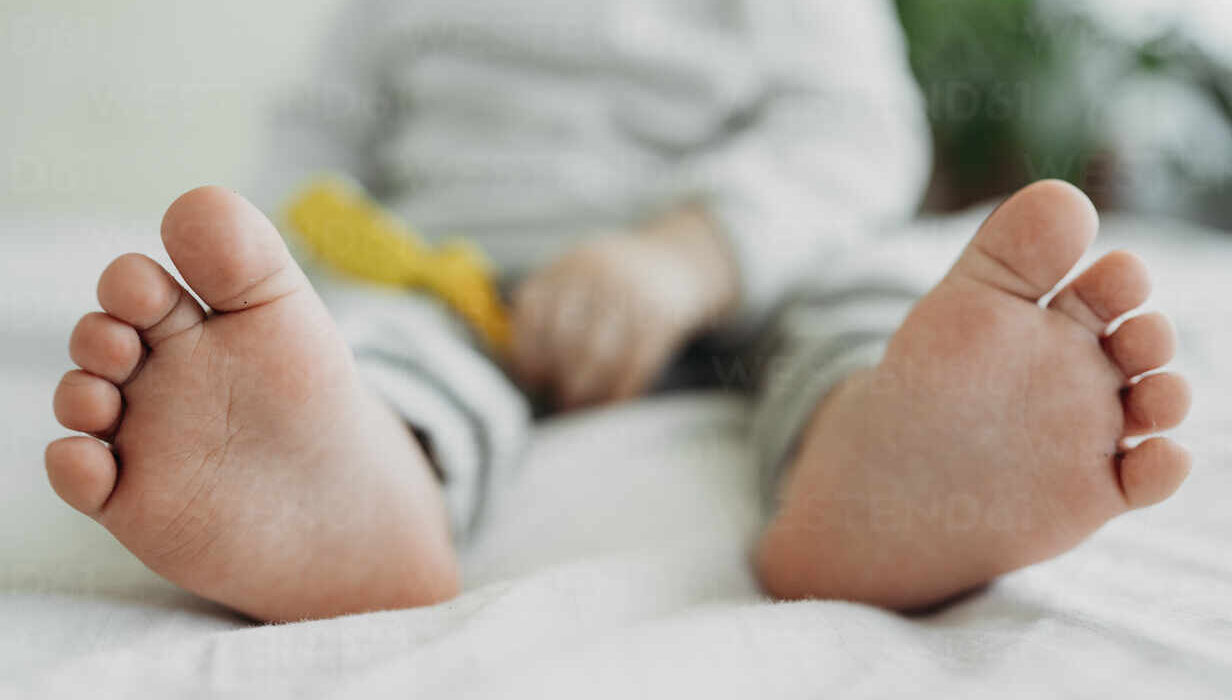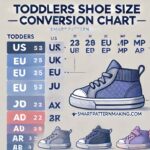Toddler feet grow quickly, typically about half a size every 2 to 3 months. By age three, children’s feet can grow as much as 1.5 sizes in a year.
Parents often wonder about their toddler’s foot growth. Understanding this can help ensure proper shoe fitting. Toddler feet are delicate and grow rapidly. During the first few years, they develop the right shape and strength. Most children experience fast growth, especially between ages 1 and 3.
Regularly checking shoe size is essential. Ill-fitting shoes can cause discomfort and problems. Parents should measure their child’s feet every few months. This helps to keep up with their growth. Finding well-fitting shoes is key for healthy foot development. Pay attention to signs of discomfort or tightness in shoes.
Table of Contents
Tiny Steps To Big Strides
Toddler feet grow rapidly. Understanding this growth helps parents choose the right shoes. Children need proper support as they take their first steps. These tiny feet lead to big adventures.
Growth Spurts In Toddler Feet
Toddler feet can grow surprisingly fast. Most children experience growth spurts. These spurts occur at different times for each child.
- Age 1: Growth of about 1.5 sizes.
- Age 2: Growth of about 1 size.
- Age 3: Growth of about 1 size.
- Age 4: Growth of about 0.5 sizes.
Monitoring your toddler’s foot size is essential. Regular checks can prevent discomfort. Look for signs like:
- Cramped toes.
- Worn-out shoes.
- Complaints about pain.
The Pace Of Development
Toddler feet typically grow about 1 to 2 sizes each year. This growth slows down as they approach school age. Understanding this pace helps parents buy shoes wisely.
Here is a simple table showing average growth:
| Age | Average Size Increase |
|---|---|
| 0-12 months | 1-2 sizes |
| 1-2 years | 1-1.5 sizes |
| 2-3 years | 1 size |
| 3-4 years | 0.5 sizes |
Keep track of your child’s shoe size. This knowledge helps maintain comfort. Happy feet make happy toddlers!

Credit: www.bobux.com
The Science Behind Growth
Understanding how toddler feet grow is fascinating. This growth occurs rapidly during early childhood. Several factors influence this process. Let’s explore the physiological factors and genetic influences behind foot growth.
Physiological Factors
Toddler feet grow due to several physiological factors. Here are some key points:
- Bone Development: Feet are made of bones that grow longer and wider.
- Muscle Growth: Muscles in the feet strengthen and develop.
- Fat Padding: A layer of fat cushions toddler feet, influencing size.
- Hormones: Growth hormones play a significant role in overall growth.
The average toddler’s foot grows about half a size every 3-4 months. This rapid growth can vary among children.
Genetic Influences
Genetics significantly impacts foot size and growth rate. Here’s how:
- Parental Foot Size: Children often inherit foot size from parents.
- Family Traits: Growth patterns can run in families.
- Ethnic Background: Different ethnicities may have varying growth rates.
Genetic factors can lead to noticeable differences in foot size. These differences can affect shoe fitting and comfort.
| Factor | Impact on Growth |
|---|---|
| Bone Development | Increases foot length and width |
| Muscle Growth | Enhances stability and strength |
| Fat Padding | Affects comfort and size perception |
| Hormones | Regulates overall growth rate |
| Genetics | Determines size inheritance and growth patterns |
Measuring Little Feet
Measuring your toddler’s feet is important. It helps you find the right shoe size. Proper shoes support their growing feet. Regular measurements ensure comfort and health.
Tools And Techniques
Several tools help measure toddler feet accurately. Here are some effective methods:
- Brannock Device: This tool gives precise measurements.
- Ruler or Measuring Tape: Use these for a DIY approach.
- Printable Size Chart: Many websites offer printable foot size charts.
To measure, follow these simple steps:
- Have your child stand on a flat surface.
- Measure from the heel to the longest toe.
- Record the measurement in inches or centimeters.
When To Measure
Measuring your toddler’s feet should be regular. Check their feet every 2 to 3 months. Growth spurts can happen quickly.
Signs that it’s time to measure include:
- Shoes feel tight or uncomfortable.
- Your child complains of foot pain.
- Visible growth in their feet since the last measurement.
Keep track of their shoe sizes in a table:
| Age | Average Size |
|---|---|
| 1-2 years | Size 4-6 |
| 2-3 years | Size 6-8 |
| 3-4 years | Size 8-10 |
| 4-5 years | Size 10-12 |
Signs Of Outgrowing Shoes
As toddlers grow, their feet change rapidly. Parents must watch for signs indicating it’s time for new shoes. Early detection helps ensure comfort and proper foot development.
Recognizing The Time For New Shoes
Here are some key signs that show your child needs new shoes:
- Toe Crowding: If toes touch the front of the shoe.
- Visible Wear: Check for worn-out soles or damaged sides.
- Foot Pain: Complaints of discomfort or pain while walking.
- Foul Odor: Persistent bad smell may indicate shoe size issues.
- Frequent Tripping: This can signal improper fit and support.
Common Misconceptions
Many parents have misconceptions about toddler footwear. Here are some myths to clear up:
| Myth | Fact |
|---|---|
| All shoes fit all kids. | Each child has unique foot shapes and sizes. |
| They can wear shoes longer than 6 months. | Most toddlers need new shoes every 2-3 months. |
| Big shoes allow for growth. | Too big shoes can cause tripping and discomfort. |
| Quality shoes aren’t important. | Good quality shoes support healthy foot development. |
Stay informed to keep your toddler’s feet healthy. Regularly check their shoe fit as they grow.
Choosing The Right Shoe Size
Selecting the correct shoe size for toddlers is essential. Their feet grow quickly and need proper support. Shoes that fit well help with balance and comfort. Poorly fitting shoes can cause pain and problems.
Size Guides And Tips
Understanding shoe sizes is important for parents. Use size guides to measure your toddler’s feet accurately. Here are some tips:
- Measure feet in the afternoon. Feet swell during the day.
- Check both feet. One foot might be larger than the other.
- Leave space. There should be a thumb’s width between the toe and shoe end.
- Consider width. Some children need wider shoes.
| Age Group | Average Shoe Size |
|---|---|
| 1-2 years | 4-6 |
| 2-3 years | 6-8 |
| 3-4 years | 8-10 |
The Importance Of Proper Fit
Properly fitting shoes provide many benefits. Here are some key reasons:
- Comfort: Shoes that fit well allow for easy movement.
- Health: Good fit prevents foot problems.
- Safety: Proper shoes reduce the risk of falls.
- Development: Supports natural foot growth and development.
Always check for signs of discomfort. Red marks or blisters indicate poor fit. Regularly measure your toddler’s feet. Their shoe size can change every few months.
Shopping For Toddler Shoes
Choosing the right shoes for toddlers is crucial. Their feet grow rapidly, needing regular updates to footwear. Proper shoes support healthy foot development and comfort during play.
Best Practices
Follow these best practices for shopping toddler shoes:
- Measure Feet Regularly: Check foot size every 2-3 months.
- Choose the Right Fit: Shoes should have a thumb’s width of space at the toe.
- Opt for Lightweight Materials: Lightweight shoes allow for easier movement.
- Look for Adjustable Features: Velcro straps or laces provide a snug fit.
- Prioritize Comfort: Shoes should feel comfortable immediately.
Durability Versus Growth
Balancing durability and growth can be tricky. Toddler shoes need to withstand daily play but also accommodate growth.
| Aspect | Durability | Growth |
|---|---|---|
| Material | Choose sturdy materials like leather or rubber. | Soft, flexible materials allow for foot expansion. |
| Design | Reinforced toes and heels enhance longevity. | Look for styles with adjustable straps for a better fit. |
| Cost | Durable shoes may cost more but last longer. | Frequent purchases are needed for growing feet. |
Finding the right balance ensures your child has supportive shoes that last. Regularly assess how the shoes fit as your toddler grows.
The Impact Of Ill-fitting Shoes
Choosing the right shoes for toddlers is crucial. Ill-fitting shoes can cause pain and discomfort. They can lead to serious foot problems. Understanding the impact of these shoes helps parents make informed choices.
Potential Foot Problems
Ill-fitting shoes can lead to various foot issues in toddlers. Common problems include:
- Blisters: Friction from tight shoes can cause painful blisters.
- Calluses: Hard skin forms from constant pressure and rubbing.
- Flat Feet: Poor support may cause the arches to collapse.
- Ingrown Toenails: Tight shoes can push nails into the skin.
- Foot Pain: Discomfort can affect walking and play.
These problems can affect a child’s overall development. Proper shoe fitting is essential for healthy growth.
Long-term Consequences
Ill-fitting shoes can have lasting effects on a child’s feet. Here are some potential long-term consequences:
- Deformities: Misalignment can cause permanent foot deformities.
- Persistent Pain: Chronic pain may develop from early discomfort.
- Difficulty Walking: Problems can lead to an unstable walking pattern.
- Reduced Activity: Pain may limit outdoor play and exercise.
Proper shoe fitting is vital for long-term foot health. Regularly checking shoe size can prevent many issues.
Caring For Growing Feet
Caring for toddler feet is vital for their development. Healthy feet support overall growth and mobility. As feet grow quickly, proper care ensures comfort and well-being.
Daily Foot Care
Daily foot care keeps your toddler’s feet healthy and safe. Follow these simple tips:
- Wash feet daily with warm water and mild soap.
- Dry feet thoroughly, especially between the toes.
- Inspect for any signs of redness or irritation.
- Clip toenails regularly to prevent ingrown nails.
- Moisturize dry skin with gentle lotion.
Using the right shoes is essential. Choose shoes that fit well and allow room for growth. Check the fit often, especially after growth spurts.
Encouraging Healthy Foot Development
Encouraging healthy foot development is crucial for toddlers. Follow these tips to support their growing feet:
- Let them go barefoot indoors. This helps strengthen foot muscles.
- Choose shoes that are:
- Lightweight and flexible
- Breathable materials
- Properly sized with a thumb’s width of space
- Encourage outdoor play for better balance and coordination.
- Limit time in restrictive shoes like sandals with high heels.
Proper foot care and healthy habits lead to strong, well-developed feet. Regular checks ensure your toddler stays comfortable as they grow.
Footwear For Different Activities
Choosing the right footwear for toddlers is crucial. Proper shoes support their growing feet. Different activities require different types of shoes. Let’s explore sport-specific shoes and seasonal considerations.
Sport-specific Shoes
Sports shoes help toddlers perform better in various activities. Here are some key options:
- Running Shoes: Lightweight and breathable. They provide good cushioning.
- Soccer Cleats: Offer traction on grass. They protect the feet during play.
- Basketball Shoes: High tops support ankles. They have a non-slip sole.
- Sandals for Water Activities: Quick-drying materials. They offer grip on wet surfaces.
Each sport has unique footwear needs. Choose shoes that fit well and allow movement.
Seasonal Considerations
Seasons affect footwear choices. Here are some tips for each season:
| Season | Recommended Footwear |
|---|---|
| Spring | Lightweight sneakers for outdoor play. |
| Summer | Breathable sandals for warm weather. |
| Autumn | Sturdy shoes for cooler weather. |
| Winter | Insulated boots for snow and rain. |
Always check the fit. Feet swell during the day. Choose shoes that allow for growth.

Credit: kokotree.com
Dealing With Sensitive Feet
Many toddlers have sensitive feet. This can make finding the right shoes challenging. Parents need to pay attention to materials and comfort. Proper care can help toddlers feel better.
Allergies And Materials
Some kids have allergies to certain materials. Common allergens include:
- Rubber
- Leather
- Synthetic fabrics
Choose shoes made from hypoallergenic materials. Look for:
- Organic cotton
- Soft leather
- Breathable mesh
Always check for tags that say “allergy-free.” This helps avoid rashes and discomfort.
Comfort And Support
Comfort is key for sensitive feet. Proper support helps little feet grow strong. Consider these features:
| Feature | Description |
|---|---|
| Padded Insoles | Provide cushioning for little feet. |
| Arch Support | Helps maintain foot structure. |
| Adjustable Straps | Ensure a snug fit without pressure. |
Always check the fit. A proper fit prevents blisters and soreness.
Encourage kids to walk in their new shoes. This helps them get used to the feel.
Orthopedic Considerations
Watching your toddler’s feet grow is exciting. However, growth can lead to orthopedic issues. Early detection and proper care can prevent future problems. Understanding when to seek help is crucial.
When To Consult A Specialist
Parents should monitor their toddler’s foot development closely. Look for signs that may indicate problems:
- Foot pain during walking or running
- Frequent tripping or falling
- Feet that appear flat or unusually shaped
- Difficulty fitting into shoes
Consult a specialist if you notice any of these signs. A pediatric orthopedic doctor can assess your child’s feet. Early intervention can make a significant difference.
Corrective Footwear
Choosing the right footwear is essential for growing feet. Here are some options for corrective footwear:
| Type of Footwear | Purpose |
|---|---|
| Arch Supports | Provide stability for flat feet |
| Heel Cups | Help with heel pain |
| Custom Orthotics | Correct specific foot issues |
Consult with a specialist before purchasing corrective footwear. Proper fitting is vital for comfort and support. A good shoe can help your toddler walk and run more effectively.
Economic Aspects Of Fast Growth
Toddler feet grow quickly. This rapid growth has economic implications. Parents often face unexpected costs for new shoes. Understanding these costs can help you manage your budget better.
Budgeting For New Shoes
Buying shoes for growing toddlers can strain your budget. Here are some tips to help:
- Monitor Growth: Check your child’s shoe size regularly.
- Set a Budget: Allocate funds for shoe purchases each month.
- Buy Off-Season: Purchase shoes during sales or clearance events.
Consider the following table to guide your shoe budget:
| Age (Years) | Shoe Size Increase (Approx.) | Average Cost Per Pair |
|---|---|---|
| 1-2 | 1 size every 2-3 months | $30 |
| 2-3 | 1 size every 3-4 months | $35 |
| 3-4 | 1 size every 4-6 months | $40 |
Making Shoes Last Longer
Extending the life of shoes can save money. Here are effective strategies:
- Choose Quality: Invest in durable brands.
- Use Protectors: Apply water and stain repellents.
- Rotate Shoes: Alternate between multiple pairs.
- Store Properly: Keep shoes in a cool, dry place.
These tips can reduce the frequency of purchases. Saving money becomes easier with careful planning.
Involving Toddlers In Shoe Selection
Involving toddlers in shoe selection makes shopping exciting. It helps them feel included and valued. Choosing shoes together can be a fun adventure.
Making Shoe Shopping Fun
Turn shoe shopping into a playful experience. Here are some tips:
- Visit a kid-friendly store: Look for stores designed for children.
- Use colorful displays: Bright colors grab their attention.
- Let them try on shoes: Encourage them to walk and run.
- Play games: Create a mini fashion show in the store.
- Bring their favorite toy: Comfort items can ease anxiety.
These simple steps make choosing shoes enjoyable. Happy toddlers often pick shoes they love.
Teaching Self-expression Through Footwear
Shoes are more than just protection. They are a way for toddlers to express themselves. Here’s how to encourage self-expression:
- Discuss colors and styles: Ask them what they like.
- Introduce themes: Superheroes, animals, or favorite characters.
- Encourage mix-and-match: Let them pair shoes with outfits.
Self-expression boosts their confidence. Celebrate their unique choices. This builds a sense of identity.

Credit: afcdallas.com
Frequently Asked Questions
How Fast Do Toddler Feet Grow?
Toddler feet typically grow about half a size every three to four months during their early years.
What Are Signs Of Shoe Size Change?
Look for tightness, discomfort, or visible pressure marks on the foot as signs that shoes no longer fit.
How Often Should I Measure Toddler Feet?
Measure toddler feet every three to four months to ensure they are wearing the correct shoe size for comfort and support.
Why Do Toddler Feet Grow So Quickly?
Rapid foot growth in toddlers supports their overall physical development and helps them adapt to new activities and movements.
Conclusion
Toddler feet grow fast and need regular checks. Parents should measure their child’s feet often. Buying the right size helps prevent discomfort. Choose shoes that fit well and support little feet. This way, kids can walk, run, and play happily.
Keep an eye on those growing feet for happy adventures!







